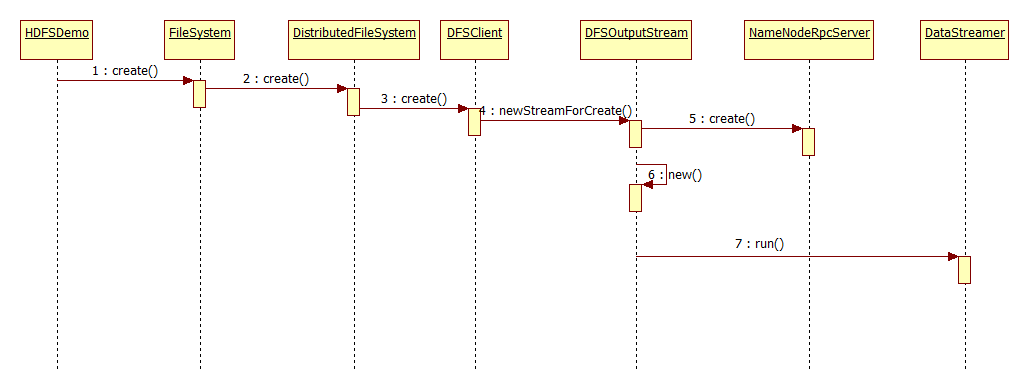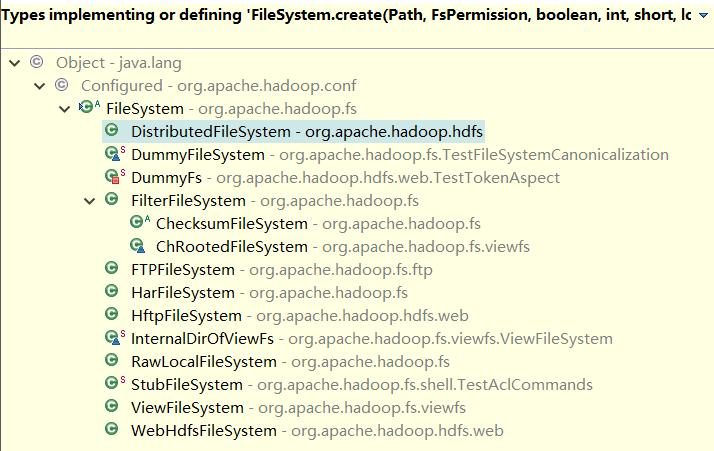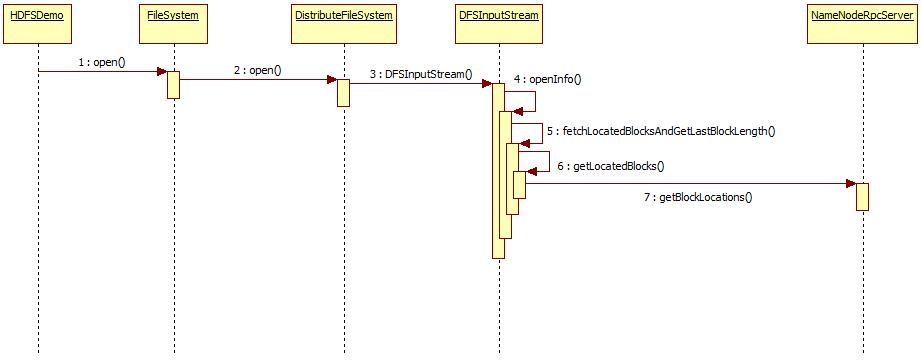上篇楼主主要介绍了hdfs原理及FileSystem的初始化源码解析, Client如何与NameNode建立RPC通信。本篇将继续介绍hdfs文件上传、下载源解析。
文件上传
先上文件上传的方法调用过程时序图:

其主要执行过程:
- FileSystem初始化,Client拿到NameNodeRpcServer代理对象,建立与NameNode的RPC通信(楼主已经介绍过了)
- 调用FileSystem的create()方法,由于实现类为DistributedFileSystem,所有是调用该类中的create()方法
- DistributedFileSystem持有DFSClient的引用,继续调用DFSClient中的create()方法
- DFSOutputStream提供的静态newStreamForCreate()方法中调用NameNodeRpcServer服务端的create()方法并创建DFSOutputStream输出流对象返回
- 通过hadoop提供的IOUtil工具类将输出流输出到本地
下面我们来看下源码:
首先初始化文件系统,建立与服务端的RPC通信
1 HDFSDemo.java2 OutputStream os = fs.create(new Path("/test.log"));
调用FileSystem的create()方法,由于FileSystem是一个抽象类,这里实际上是调用的该类的子类create()方法
1 //FileSystem.java2 public abstract FSDataOutputStream create(Path f,3 FsPermission permission,4 boolean overwrite,5 int bufferSize,6 short replication,7 long blockSize,8 Progressable progress) throws IOException;
前面我们已经说过FileSystem.get()返回的是DistributedFileSystem对象,所以这里我们直接进入DistributedFileSystem:

1 //DistributedFileSystem.java 2 @Override 3 public FSDataOutputStream create(final Path f, final FsPermission permission, 4 final EnumSetcflags, final int bufferSize, 5 final short replication, final long blockSize, final Progressable progress, 6 final ChecksumOpt checksumOpt) throws IOException { 7 statistics.incrementWriteOps(1); 8 Path absF = fixRelativePart(f); 9 return new FileSystemLinkResolver () {10 @Override11 public FSDataOutputStream doCall(final Path p)12 throws IOException, UnresolvedLinkException {13 final DFSOutputStream dfsos = dfs.create(getPathName(p), permission,14 cflags, replication, blockSize, progress, bufferSize,15 checksumOpt);16 //dfs为DistributedFileSystem所持有的DFSClient对象,这里调用DFSClient中的create()方法17 return dfs.createWrappedOutputStream(dfsos, statistics);18 }19 @Override20 public FSDataOutputStream next(final FileSystem fs, final Path p)21 throws IOException {22 return fs.create(p, permission, cflags, bufferSize,23 replication, blockSize, progress, checksumOpt);24 }25 }.resolve(this, absF);26 }
DFSClient的create()返回一个DFSOutputStream对象:
1 //DFSClient.java 2 public DFSOutputStream create(String src, 3 FsPermission permission, 4 EnumSetflag, 5 boolean createParent, 6 short replication, 7 long blockSize, 8 Progressable progress, 9 int buffersize,10 ChecksumOpt checksumOpt,11 InetSocketAddress[] favoredNodes) throws IOException {12 checkOpen();13 if (permission == null) {14 permission = FsPermission.getFileDefault();15 }16 FsPermission masked = permission.applyUMask(dfsClientConf.uMask);17 if(LOG.isDebugEnabled()) {18 LOG.debug(src + ": masked=" + masked);19 }20 //调用DFSOutputStream的静态方法newStreamForCreate,返回输出流21 final DFSOutputStream result = DFSOutputStream.newStreamForCreate(this,22 src, masked, flag, createParent, replication, blockSize, progress,23 buffersize, dfsClientConf.createChecksum(checksumOpt),24 getFavoredNodesStr(favoredNodes));25 beginFileLease(result.getFileId(), result);26 return result;27 }
我们继续看下newStreamForCreate()中的业务逻辑:
1 //DFSOutputStream.java 2 static DFSOutputStream newStreamForCreate(DFSClient dfsClient, String src, 3 FsPermission masked, EnumSetflag, boolean createParent, 4 short replication, long blockSize, Progressable progress, int buffersize, 5 DataChecksum checksum, String[] favoredNodes) throws IOException { 6 TraceScope scope = 7 dfsClient.getPathTraceScope("newStreamForCreate", src); 8 try { 9 HdfsFileStatus stat = null;10 boolean shouldRetry = true;11 int retryCount = CREATE_RETRY_COUNT;12 while (shouldRetry) {13 shouldRetry = false;14 try {15 //这里通过dfsClient的NameNode代理对象调用NameNodeRpcServer中实现的create()方法16 stat = dfsClient.namenode.create(src, masked, dfsClient.clientName,17 new EnumSetWritable (flag), createParent, replication,18 blockSize, SUPPORTED_CRYPTO_VERSIONS);19 break;20 } catch (RemoteException re) {21 IOException e = re.unwrapRemoteException(22 AccessControlException.class,23 DSQuotaExceededException.class,24 FileAlreadyExistsException.class,25 FileNotFoundException.class,26 ParentNotDirectoryException.class,27 NSQuotaExceededException.class,28 RetryStartFileException.class,29 SafeModeException.class,30 UnresolvedPathException.class,31 SnapshotAccessControlException.class,32 UnknownCryptoProtocolVersionException.class);33 if (e instanceof RetryStartFileException) {34 if (retryCount > 0) {35 shouldRetry = true;36 retryCount--;37 } else {38 throw new IOException("Too many retries because of encryption" +39 " zone operations", e);40 }41 } else {42 throw e;43 }44 }45 }46 Preconditions.checkNotNull(stat, "HdfsFileStatus should not be null!");47 //new输出流对象48 final DFSOutputStream out = new DFSOutputStream(dfsClient, src, stat,49 flag, progress, checksum, favoredNodes);50 out.start();//调用内部类DataStreamer的start()方法,DataStreamer继承Thread,所以说这是一个线程,从NameNode中申请新的block信息; 同时前面我们介绍hdfs原理的时候提到的流水线作业(Pipeline)也是在这里实现,有兴趣的同学可以去研究下,这里就不带大家看了51 return out;52 } finally {53 scope.close();54 }55 }
到此,Client拿到了服务端的输出流对象,那么后面就容易了,都是一些简答的文件输出,输入流的操作(hadoop提供的IOUitl)。
文件下载
文件上传的大致流程与文件下载类似,与上传一样,我们先上程序方法调用时序图:

主要执行过程:
- FileSystem初始化,Client拿到NameNodeRpcServer代理对象,建立与NameNode的RPC通信(与前面一样)
- 调用FileSystem的open()方法,由于实现类为DistributedFileSystem,所有是调用该类中的open()方法
- DistributedFileSystem持有DFSClient的引用,继续调用DFSClient中的open()方法
- 实例化DFSInputStream输入流
- 调用openinfo()方法
- 调用fetchLocatedBlocksAndGetLastBlockLength()方法,抓取block信息并获取最后block长度
- 调用DFSClient中的getLocatedBlocks()方法,获取block信息
- 在callGetBlockLocations()方法中通过NameNode代理对象调用NameNodeRpcServer的getBlockLocations()方法
- 将block信息写入输出流
- 交给IOUtil,下载文件到本地
接下来,我们开始看源码:
首先任然是FileSystem的初始化,前面有,这里就不贴出来了,我们直接从DistributedFileSystem的open()开始看。
1 //DistributedFifeSystem.java 2 @Override 3 public FSDataInputStream open(Path f, final int bufferSize) 4 throws IOException { 5 statistics.incrementReadOps(1); 6 Path absF = fixRelativePart(f); 7 return new FileSystemLinkResolver () { 8 @Override 9 public FSDataInputStream doCall(final Path p)10 throws IOException, UnresolvedLinkException {11 final DFSInputStream dfsis =12 dfs.open(getPathName(p), bufferSize, verifyChecksum);13 //dfs为DFSClient对象,调用open()返回输入流14 return dfs.createWrappedInputStream(dfsis);15 }16 @Override17 public FSDataInputStream next(final FileSystem fs, final Path p)18 throws IOException {19 return fs.open(p, bufferSize);20 }21 }.resolve(this, absF);22 } DFSClient中并没有直接使用NameNode的代理对象,而是传给了DFSInputStream:
1 //DFSClient.java 2 public DFSInputStream open(String src, int buffersize, boolean verifyChecksum) 3 throws IOException, UnresolvedLinkException { 4 checkOpen(); 5 TraceScope scope = getPathTraceScope("newDFSInputStream", src); 6 try { 7 //这里并没有直接通过NameNode的代理对象调用服务端的方法,直接new输入流并把当前对象作为参数传入 8 return new DFSInputStream(this, src, verifyChecksum); 9 } finally {10 scope.close();11 }12 } 那么在DFSInputStream必须持有DFSClient的引用:
1 //DFSInputStream.java 构造 2 DFSInputStream(DFSClient dfsClient, String src, boolean verifyChecksum 3 ) throws IOException, UnresolvedLinkException { 4 this.dfsClient = dfsClient;//只有DFSClient的引用 5 this.verifyChecksum = verifyChecksum; 6 this.src = src; 7 synchronized (infoLock) { 8 this.cachingStrategy = dfsClient.getDefaultReadCachingStrategy(); 9 }10 openInfo();//调openInfo()11 } openInfo()用来抓取block信息:
1 void openInfo() throws IOException, UnresolvedLinkException { 2 synchronized(infoLock) { 3 lastBlockBeingWrittenLength = fetchLocatedBlocksAndGetLastBlockLength();//抓取block信息 4 int retriesForLastBlockLength = dfsClient.getConf().retryTimesForGetLastBlockLength;//获取配置信息,尝试抓取的次数,楼主记得在2.6以前这里写的3;当然,现在的默认值也为3 5 while (retriesForLastBlockLength > 0) { 6 if (lastBlockBeingWrittenLength == -1) { 7 DFSClient.LOG.warn("Last block locations not available. " 8 + "Datanodes might not have reported blocks completely." 9 + " Will retry for " + retriesForLastBlockLength + " times");10 waitFor(dfsClient.getConf().retryIntervalForGetLastBlockLength);11 lastBlockBeingWrittenLength = fetchLocatedBlocksAndGetLastBlockLength();12 } else {13 break;14 }15 retriesForLastBlockLength--;16 }17 if (retriesForLastBlockLength == 0) {18 throw new IOException("Could not obtain the last block locations.");19 }20 }21 }
获取block信息:
1 //DFSInputStream.java 2 private long fetchLocatedBlocksAndGetLastBlockLength() throws IOException { 3 final LocatedBlocks newInfo = dfsClient.getLocatedBlocks(src, 0); 4 //回到DFSClient中来获取当前block信息 5 if (DFSClient.LOG.isDebugEnabled()) { 6 DFSClient.LOG.debug("newInfo = " + newInfo); 7 } 8 if (newInfo == null) { 9 throw new IOException("Cannot open filename " + src);10 }11 12 if (locatedBlocks != null) {13 Iterator oldIter = locatedBlocks.getLocatedBlocks().iterator();14 Iterator newIter = newInfo.getLocatedBlocks().iterator();15 while (oldIter.hasNext() && newIter.hasNext()) {16 if (! oldIter.next().getBlock().equals(newIter.next().getBlock())) {17 throw new IOException("Blocklist for " + src + " has changed!");18 }19 }20 }21 locatedBlocks = newInfo;22 long lastBlockBeingWrittenLength = 0;23 if (!locatedBlocks.isLastBlockComplete()) {24 final LocatedBlock last = locatedBlocks.getLastLocatedBlock();25 if (last != null) {26 if (last.getLocations().length == 0) {27 if (last.getBlockSize() == 0) { 28 return 0;29 }30 return -1;31 }32 final long len = readBlockLength(last);33 last.getBlock().setNumBytes(len);34 lastBlockBeingWrittenLength = len; 35 }36 }37 38 fileEncryptionInfo = locatedBlocks.getFileEncryptionInfo();39 //返回block开始写的位置40 return lastBlockBeingWrittenLength;41 } 回到DFSClient中:
1 DFSClient.java 2 @VisibleForTesting 3 public LocatedBlocks getLocatedBlocks(String src, long start, long length) 4 throws IOException { 5 TraceScope scope = getPathTraceScope("getBlockLocations", src); 6 try { 7 //这里NameNode作为参数传递到callGetBlockLocations()中 8 return callGetBlockLocations(namenode, src, start, length); 9 } finally {10 scope.close();11 }12 } 调用服务端方法,返回block信息:
1 //DFSClient.java 2 static LocatedBlocks callGetBlockLocations(ClientProtocol namenode, 3 String src, long start, long length) 4 throws IOException { 5 try { 6 //看到这里,不用做过多的解释了吧? 7 return namenode.getBlockLocations(src, start, length); 8 } catch(RemoteException re) { 9 throw re.unwrapRemoteException(AccessControlException.class,10 FileNotFoundException.class,11 UnresolvedPathException.class);12 }13 } 最终将文件block相关信息写入输入流,通过工具类IOUtil输出到本地文件。
那关于hadoop之hdfs原理及文件上传下载源码解析就写到这里,下系列的文章,楼主会写一些关于mapreduce或者hive相关的文章分享给大家。
示例代码地址: